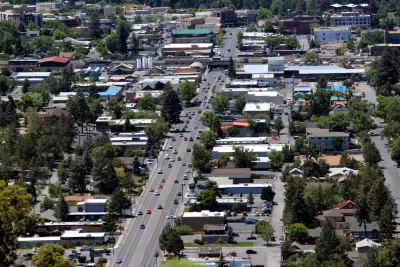Financial projections from the state's Department of Transportation suggest the agency does not anticipate a marked reduction in driving in the next decade.

Despite a mandate to reduce carbon emissions by 45 percent across state agencies, the Oregon Department of Transportation's financial projections show little progress, reports Rachel Monahan. Based on gas tax revenue projections, "ODOT has made commitments to the financial markets where it sells bonds to finance road projects that make clear the agency is actually counting on emissions to continue. The revenue forecast doesn’t say emissions, but it readily translates to exhaust coming out of tailpipes."
According to ODOT projections, cars and trucks will emit 19.3 million metric tons of CO2 annually. But to meet the 45 percent goal, the state would need to reduce emissions by 12 million metric tons each year. An ODOT spokesperson acknowledged the pattern, saying "ODOT revenue forecasts are based purely on consumer patterns and historical data" rather than future goals. The projections also do not account for potential reductions in vehicle miles traveled thanks to congestion pricing schemes and other initiatives aimed at reducing driving.
FULL STORY: ODOT Projects Gas Guzzling Won’t Decline, Even as It Pays Lip Service to Meeting Climate Goals

Alabama: Trump Terminates Settlements for Black Communities Harmed By Raw Sewage
Trump deemed the landmark civil rights agreement “illegal DEI and environmental justice policy.”

Planetizen Federal Action Tracker
A weekly monitor of how Trump’s orders and actions are impacting planners and planning in America.

The 120 Year Old Tiny Home Villages That Sheltered San Francisco’s Earthquake Refugees
More than a century ago, San Francisco mobilized to house thousands of residents displaced by the 1906 earthquake. Could their strategy offer a model for the present?

In Both Crashes and Crime, Public Transportation is Far Safer than Driving
Contrary to popular assumptions, public transportation has far lower crash and crime rates than automobile travel. For safer communities, improve and encourage transit travel.

Report: Zoning Reforms Should Complement Nashville’s Ambitious Transit Plan
Without reform, restrictive zoning codes will limit the impact of the city’s planned transit expansion and could exclude some of the residents who depend on transit the most.

Judge Orders Release of Frozen IRA, IIJA Funding
The decision is a victory for environmental groups who charged that freezing funds for critical infrastructure and disaster response programs caused “real and irreparable harm” to communities.
Urban Design for Planners 1: Software Tools
This six-course series explores essential urban design concepts using open source software and equips planners with the tools they need to participate fully in the urban design process.
Planning for Universal Design
Learn the tools for implementing Universal Design in planning regulations.
Clanton & Associates, Inc.
Jessamine County Fiscal Court
Institute for Housing and Urban Development Studies (IHS)
City of Grandview
Harvard GSD Executive Education
Toledo-Lucas County Plan Commissions
Salt Lake City
NYU Wagner Graduate School of Public Service





























